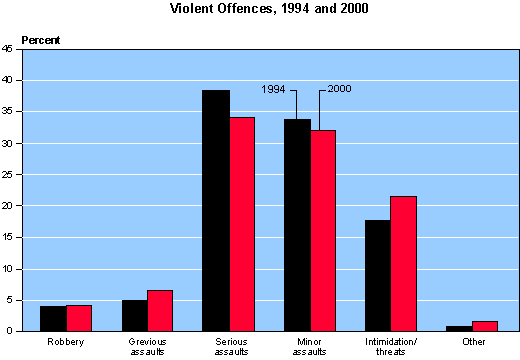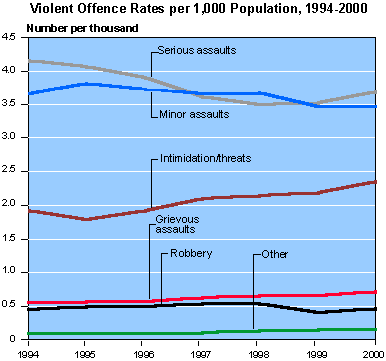| crime.files |
| |
 |
|

| crime.features |
| |
 |
|

| crime.resources |
| |
 |
|

| crime.co.nz |
| |
 |
|


|
 |  |

Violent crime
While the media attention given to violent crime may be out of proportion in terms of its contribution to overall crime levels, the effect of violent crime on the victims and the general public's perception of community safety contributes to its high profile.
Figure 10 shows that serious assaults, minor assaults and intimidation or threats together account for about 88 percent of all violent crime. Over the period 1994 to 2000, the contribution of serious and minor assaults to the total number of recorded violent crimes fell, while all other classes of violent crime increased to varying degrees. Owing to the small number of homicides, kidnapping and abductions, and group assemblies, these crimes have been combined into the 'other' category in figures 10 and 11.
Figure 10:

There was little change in the offence rates for all classes of violent crime between 1994 and 2000. The largest overall change occurred in the serious assaults class of offence. The rate for this class decreased from 4.2 to 3.5 offences per 1,000 population in 1998 before increasing slightly to 3.7 offences per 1,000 population in 2000. More than half of all serious assaults were assaults by males on females. The police practice of arresting perpetrators of family violence, developed since the late 1980s, is likely to have had an effect on the number of recorded assaults by male on female. The second most common type of serious assault was miscellaneous common assaults, 20 to 30 percent of all serious assaults were classified as miscellaneous common assaults between 1994 and 2000. There was also a small rise in the offence rate for intimidation or threats over the period.
Figure 11:

The resolution rates for all classes of violent offences remained steady from 1994 to 2000. Robbery offences had a resolution rate of about 35 percent over the period. The resolution rates for the other classes were all between 68 percent and 83 percent.
Homicides rate high in the public's concern about violent crime, but such crimes made up less than 0.4 percent of all violent crimes recorded between 1994 and 2000. The low numbers of homicide offences recorded make it impossible to identify any trends in the offence rates for any types of homicide over the period. Between 1994 and 2000, the number of recorded murders ranged from 40 to 66 per year, attempted murders (31 to 61), manslaughters (8 to 23), infanticide (0 to 2), abortion-related offences (1 to 6) and aiding suicide and pact (0 to 7).
|
 |
|

Although violent crime has traditionally aroused the most public concern and comment, it constitutes only approximately 10 percent of all recorded offences. |
|